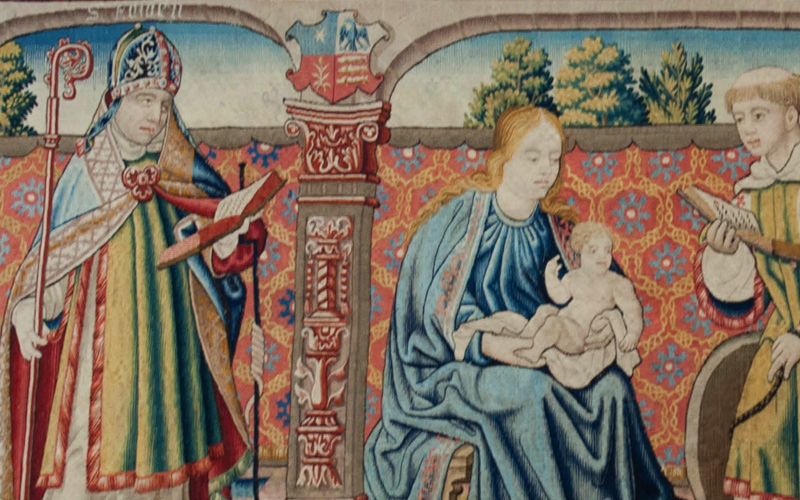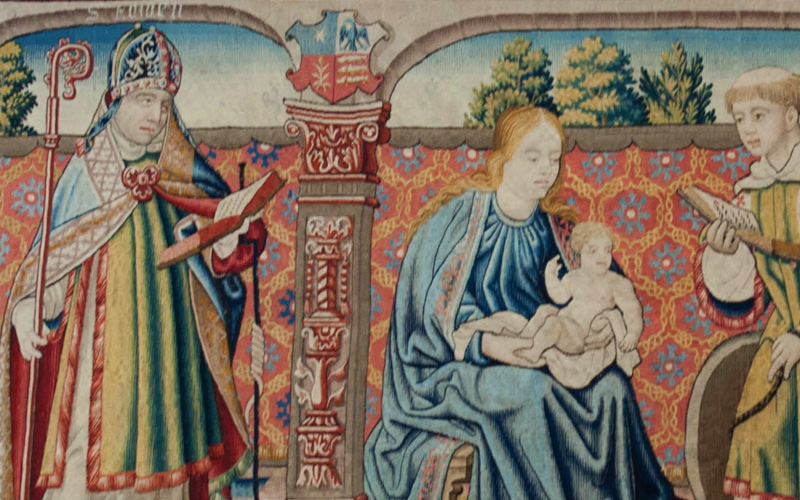Archived Content
In an effort to keep ICE.gov current, the archive contains content from a previous administration or is otherwise outdated. This information is archived and not reflective of current practice.
TOP STORY: ICE returns stolen 16th century tapestry to Spain
WASHINGTON – U.S. Immigration and Customs Enforcement (ICE) returned a 16th century tapestry, stolen in 1979 from a church, to the government of Spain Wednesday at a repatriation ceremony at the Spanish ambassador's residence in Washington. The tapestry was seized by ICE's Homeland Security Investigations (HSI) special agents in Houston after it was sold at auction.
The wool and silk tapestry was stolen in December 1979 from a national cathedral in Roda de Isábena, in the province of Huesca, Aragon, Spain. The tapestry depicts St. Ramon, the Virgin Mary with infant Jesus, Saint Vincent of Saragossa and Saint Valerius, used as an altar piece in the Romanesque cathedral. The tapestry was produced in the early 1500s and was part of the church's collection when the cathedral was declared a national monument by royal decree in 1924.
The return of this cultural property to Spain is the culmination of an investigation by HSI Houston, HSI Madrid, U.S. Attorney's Office for the Southern District of Texas, Department of Justice's (DOJ) Office of International Affairs, Belgian National Police, Spanish Civil Guard (Guardía Civil) and its Historical Heritage Protection Group.
The repatriation ceremony was conducted by ICE Director John Morton, Spanish Ambassador to the United States Ramón Gil-Casares, DOJ Office of International Affairs Director Mary Ellen Warlow, Spain's General Director of Fine Arts Jesús Prieto de Pedro and Chief of Central Operational Unit Pedro Ortega Calahorro of the Guardía Civil.
"The plundering of cultural property is one of the oldest forms of organized cross-border crime," said ICE Director Morton. "Homeland Security Investigations understands the cultural and historical significance of protecting a country's treasures and we are pleased today that this 16th century tapestry will be returned to the people of Spain. Today's repatriation is an example of what can be accomplished when law enforcement partners from around the world work together in the effort to ensure that stolen and looted priceless cultural objects like this are returned to their rightful owner."
Ambassador Gil-Casares said, "I thank U.S. Immigration and Customs Enforcement's Homeland Security Investigations special agents in Houston, Texas, for their exceptional job and great expertise in cooperation with the Central Operational Unit of the Guardía Civil that made it possible to return to Spain the 16th century tapestry robbed in 1979 from the Cathedral of St. Vincent Martyr of Roda de Isábena. It has been a great example of successful cooperation between both countries."
In November 2012, HSI special agents seized the tapestry, under the National Stolen Property Act, from a local Houston business under an HSI initiative called "Hidden Relic." This initiative is designed to investigate, recover and repatriate stolen cultural property.
The government of Spain requested assistance under the Mutual Legal Assistance Treaty in recovering the stolen tapestry after a curator at the Museum in Lérida, Spain, notified the Spanish Heritage Protection Group that the tapestry was listed for sale in a January 2010 catalog from the Brussels Antiques and Fine Art Fair. The Spanish Civil Guard notified the Belgian Police that the tapestry was stolen. An investigation was initiated and it was discovered that the tapestry was purchased in 2008 by an auction house in Munich by a Belgium gallery owner along with two partners in Milan and Paris. The tapestry was circulated in galleries in Milan and Paris before arriving in Belgium. In April 2010, the tapestry was subsequently sold at auction for $369,000 to a business in Houston.
HSI plays a leading role in criminal investigations that involve the illegal importation and distribution of cultural property, including the illicit trafficking of cultural property, especially objects that have been reported lost or stolen. The HSI Office of International Affairs, through its 75 attaché offices in 48 countries, works closely with foreign governments to conduct joint investigations, when possible.
HSI's specially trained investigators, assigned to both domestic and international offices, partner with governments, agencies and experts to protect cultural antiquities. They also provide cultural property investigative training to law enforcement partners for crimes involving stolen property and art, and how to best enforce the law to recover these items when they emerge in the marketplace.
Since 2007, more than 6,600 artifacts have been returned to 24 countries, including paintings from France, Germany, Poland and Austria, 15th to 18th century manuscripts from Italy and Peru, as well as cultural artifacts from China, Cambodia and Iraq.
Learn more about HSI cultural property, art and antiquities investigations. Members of the public who have information about suspected stolen cultural property are urged to call the toll-free HSI tip line at 1-866-DHS-2-ICE or to complete its online tip form.




